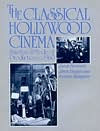5
1
9780231060554



The Classical Hollywood Cinema: Film Style and Mode of Production to 1960 / Edition 1 available in Hardcover, Paperback

The Classical Hollywood Cinema: Film Style and Mode of Production to 1960 / Edition 1
- ISBN-10:
- 0231060556
- ISBN-13:
- 9780231060554
- Pub. Date:
- 02/19/1987
- Publisher:
- Columbia University Press
- ISBN-10:
- 0231060556
- ISBN-13:
- 9780231060554
- Pub. Date:
- 02/19/1987
- Publisher:
- Columbia University Press

The Classical Hollywood Cinema: Film Style and Mode of Production to 1960 / Edition 1
$60.0
60.0
In Stock

Product Details
| ISBN-13: | 9780231060554 |
|---|---|
| Publisher: | Columbia University Press |
| Publication date: | 02/19/1987 |
| Series: | King's Crown Paperback Series |
| Edition description: | Reprint |
| Pages: | 506 |
| Sales rank: | 223,120 |
| Product dimensions: | 9.75(w) x 7.50(h) x (d) |
| Age Range: | 18 Years |
About the Author
What People are Saying About This
From the B&N Reads Blog

